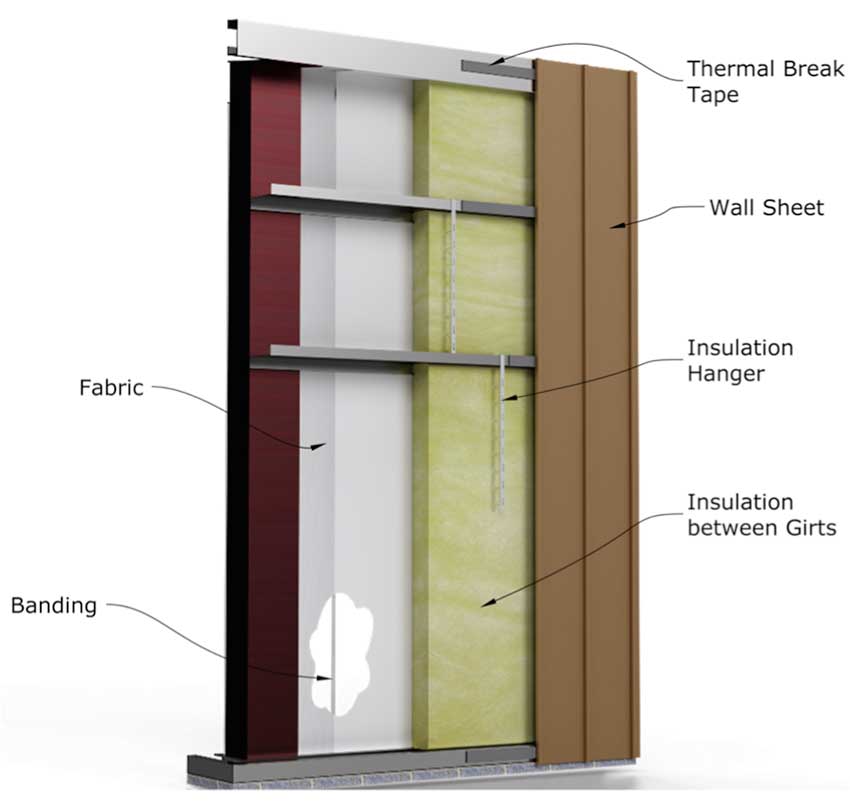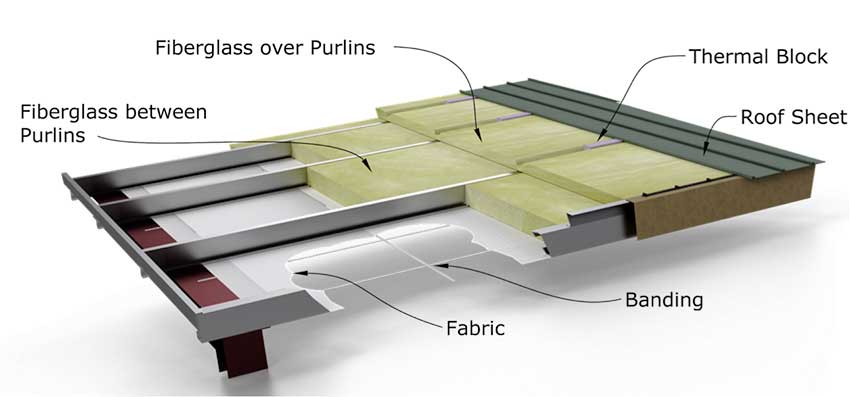Evaluating Metal Building Systems Using COMcheck™
Metal Building Wall Systems and COMcheck™
Opaque envelope wall assemblies are part of all buildings and ASHRAE-approved standard metal building wall assemblies are included in COMcheck™. These are the easiest to use when the building design matches them. Of course, many metal building system designs use other wall finishes or construction other than standard metal building system options. In this case, the user would select the appropriate wall construction system (e.g., metal studs, masonry, etc.) and select those from the ASHRAE assemblies. In the case where none of the standard assemblies match the design proposed, then thermally modeled or tested assemblies can be input for the wall systems. The building official will need to be provided with documentation of the results of the model or testing in this case.
Beyond the opaque wall areas, a significant design feature of most commercial buildings is the glass and glazing that is incorporated into a building envelope. There are many variables related to their design such as the type, size, shape, color, and configuration of the glazing, which often receive plenty of attention. There are also many variables that affect the performance and the energy code compliance of the glazing system including the percentage of glazed to opaque wall areas, the number of layers of glass, the type of glass used, glass treatments or coatings, the framing system that holds the glass, and even the type of spacers between double- or triple-paned products. It is important to recognize that all of these variables are essentially different components of a glazing system that can be controlled and specified to suit specific project conditions, climate zones, and code requirements. It is not about any one item alone (i.e., the framing system or the glass) but the entire make-up of all of them. If pre-manufactured glazing products are used, then they often come with third-party verified U-factors, solar heat gain coefficient (SHGC), and visual transmittance (VT) data that can be used in COMcheck™ calculations. If the glazing is provided by a metal building manufacturer, they should be able to provide the needed information. Conversely, the size, area, and configuration are all purely the purview of the building designer. All of the same things apply to any doors in the building, whether for the movement of people or large overhead doors for moving equipment and vehicles. Thermal values can be obtained from the manufacturer’s tested results while the size, shape, and layout are all a matter of design.
Some common questions and answers related to metal building system walls include the following:
Do I have to enter doors and windows individually or is there a more efficient method to input doors and windows?
Common door types and common window types can be “grouped” together and entered by total square feet for each individual wall surface.
How do I input “louvers?”
Louvers are generally considered to be uninsulated areas. However, there is an allowance for up to 1 percent of wall area in “recessed equipment” in walls in ASHRAE Standard 90.1-2019.
I don’t know what kinds of windows or doors are going to be used for my building yet, what do I do?
You can either use the unlabeled (code default) values in the 2021 IECC or ASHRAE Standard 90.1-2019 Normative Appendix Sections A7 and A8, or you can make conservative assumptions as to the types of windows and doors that will be installed. Code defaults assume very low-performing windows and doors and can cause the design to fail compliance. It is best to get actual data from the manufacturers.

Photo courtesy of Therm-All and the Metal Building Manufacturers Association
High-performance thermal walls in metal building systems can be designed and incorporated into COMcheck™ to show the needed level of energy conservation.
Metal Building Roof Systems and COMcheck™
Insulated roof assemblies can be a significant determinant in the energy performance of metal building systems. This is particularly true for a large building, such as retail or warehouse buildings, where the roof area is generally equal to the floor area and the exterior walls are relatively small in comparison. (This is in contrast with a tall building where the roof area may be very small compared to the extensive vertical wall area.) As with walls, using the ASHRAE-approved standard metal building roof assemblies included in COMcheck™ will be the easiest to use where the building design matches them. Otherwise, custom systems can be designed and specified using their respective published or tested thermal values.
Metal roofs also have some other characteristics that are worth noting in terms of energy performance. The first is in relation to “cool roof” requirements where they might be mandated or needed to reduce the heat generated by undesirable solar heat on a dark-colored roof. Cool roof performance is a function of two radiative properties. The first is solar reflectance (SR) which is defined by the Cool Roof Rating Council (CRRC) as, "The ratio of the reflected flux to the incident flux." In other words, it represents the fraction of light reflected off the roof. For example, "high" reflectance materials, such as white-painted metal roofing, have values of around 0.70 (a.k.a. 70 percent). That is, only 30 percent of the light from the sun is retained by the roof. The second cool roof property is infrared or thermal emittance (TE), defined by CRRC as, "The ratio of the radiant heat flux emitted by a sample to that emitted by a black body radiator at the same temperature." In plain terms, emittance is a decimal number less than one that represents the fraction of heat that is re-radiated from a material to its surroundings. Metal roofs can help keep this number low as well.
The second characteristic of metal roofs is that they can be easily used for “solar ready” and “net zero” roof options. Standing seam metal roofing makes it very easy to attach clamps or clips that do not penetrate the roofing but are quite strong and capable of attaching a solar photovoltaic array. This feature may, in some cases, be a code requirement, or it may help meet other needs of the building owner or for voluntary standards such as LEED.
With all of the above in mind, here are some common questions that can arise when addressing metal roof systems and the energy codes:
Do I have to use a Standing Seam Roof (SSR) to comply with the IECC?
If you are seeking to comply with the specific prescriptive R-value requirements in the 2021 IECC, then “Yes.” However, any assembly that has a satisfactory U-factor complies. Alternatively, some assemblies with U-factors less than the maximum may work if using trade-offs.
Is there any way for a through-fastened roof system to comply with the energy code?
A screwed-down roof in ASHRAE is defined as a through-fastened roof. Depending on the climate zone, and whether the building is conditioned or semi-heated, there are insulation systems, such as continuous insulation and liner system assemblies, that can meet the code based on published U-factors in ASHRAE 90.1-2019 Table A2.3.3. In some cases, COMcheck™ will allow a through-fastened roof to pass by installing additional insulation in the walls. Other proprietary systems are available, which have U-factors determined by testing that equal or exceed the code requirements.

Photo courtesy of Therm-All and the Metal Building Manufacturers Association
Roof systems can also achieve high thermal performance through the proper detailing and selection of metal roofing system assemblies.









